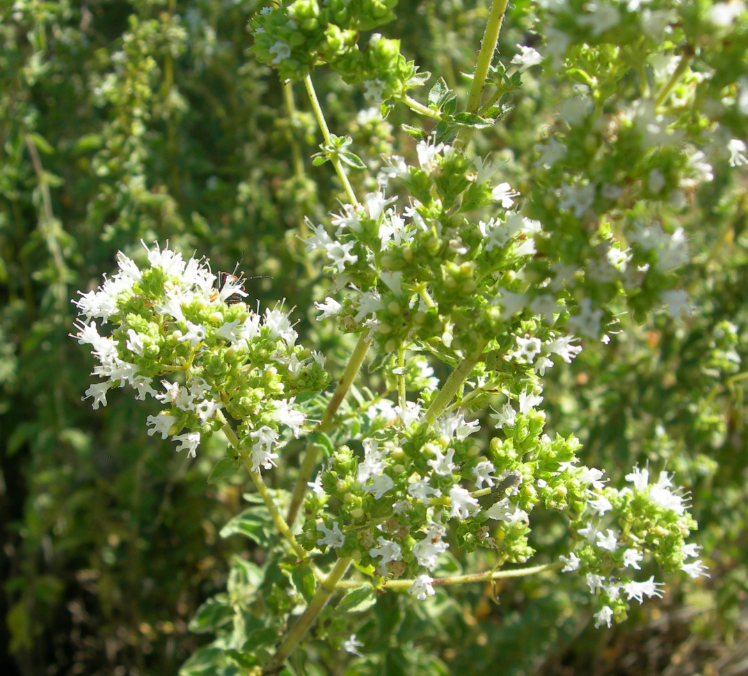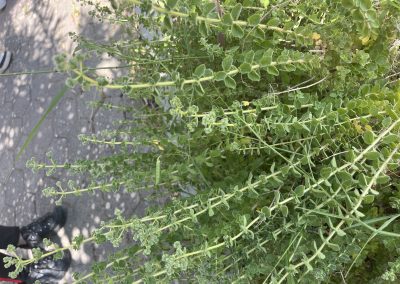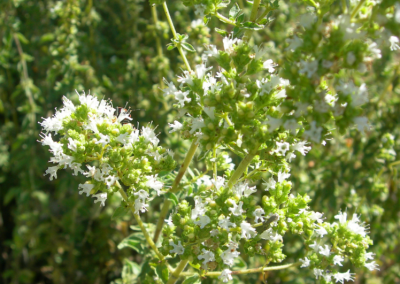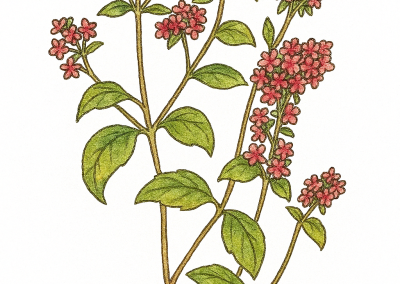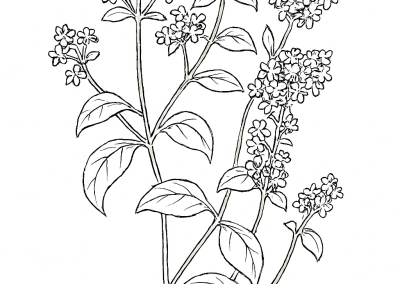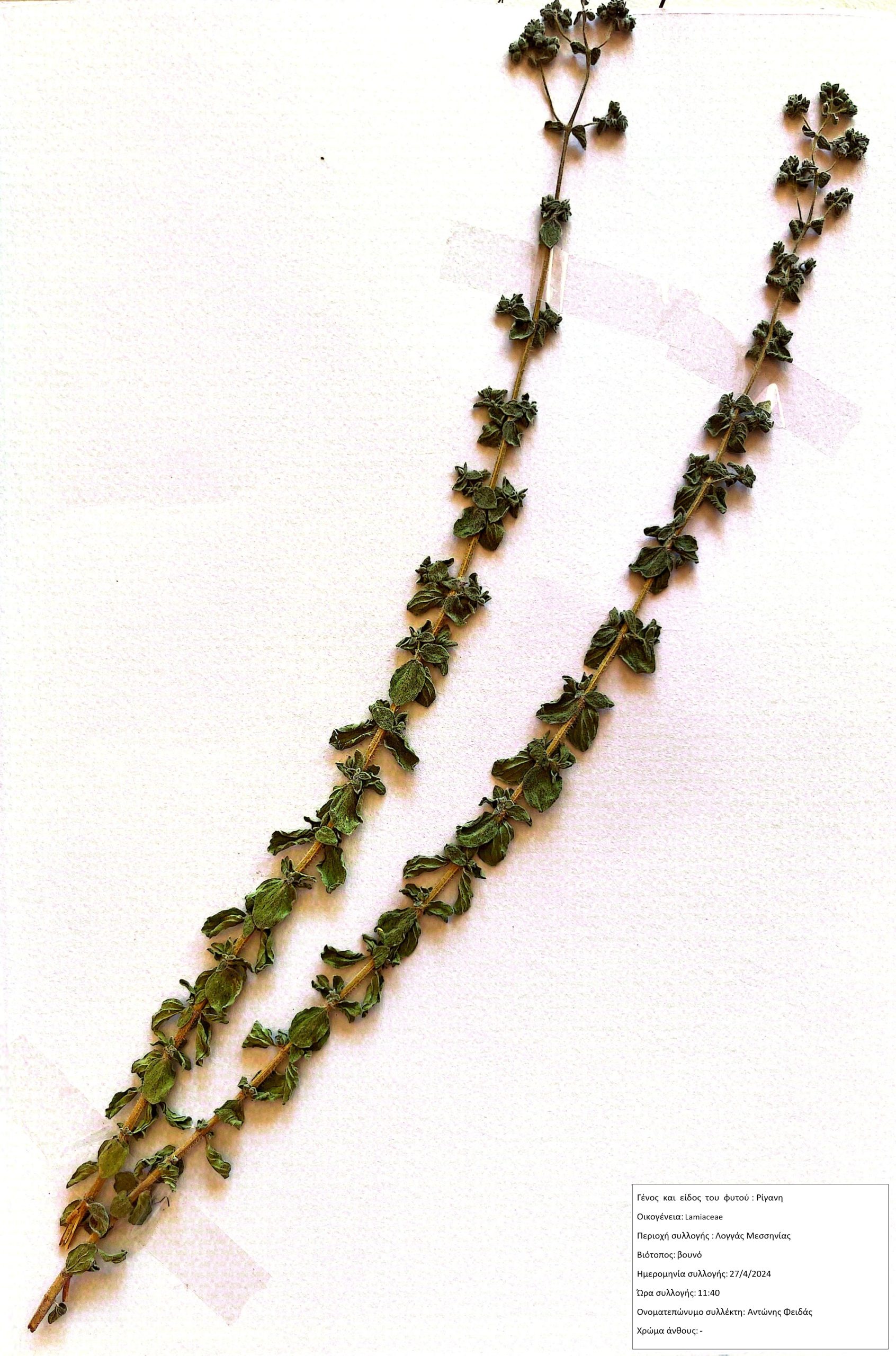Origanum vulgare
Scientific description
Scientific name: Origanum vulgare
Common names: Oregano, Wild Marjoram
Kingdom: Plantae | Phylum: Tracheophyta | Class: Magnoliopsida | Order: Lamiales | Family: Lamiaceae | Genus: Origanum | Species: O. vulgare L.
Origin: Native to Europe, the Mediterranean, and parts of Western/Central Asia. Widely naturalized in North America and other temperate regions.
Description: Hardy aromatic perennial up to 80 cm tall. Woody stems at base, oval opposite dark-green slightly hairy leaves, small purple/pink flowers in summer clusters. Highly aromatic, warm and spicy fragrance.
Propagation: By seed, cuttings/division, self-sowing.
Ecology: Attracts pollinators, found in dry grasslands, forest edges, rocky slopes. Prefers well-drained slightly alkaline soils. Sun-loving and drought-tolerant.
Usage: Culinary (Mediterranean, Italian, Middle Eastern; pizza, pasta, meats, stews), Medicinal (respiratory, digestive, immune support; antibacterial, antifungal, antioxidant—carvacrol, thymol), Symbol of joy/love in ancient Greece. Consumed fresh, dried, as tea, tincture, or essential oil.
Επιστημονική ονομασία: Origanum vulgare
Κοινές ονομασίες: Ρίγανη, Άγρια Μαντζουράνα
Βασίλειο: Φυτά | Φύλο: Tracheophyta | Κλάση: Magnoliopsida | Τάξη: Lamiales | Οικογένεια: Lamiaceae | Γένος: Origanum | Είδος: O. vulgare L.
Καταγωγή: Ευρώπη, Μεσόγειος, τμήματα Δυτικής και Κεντρικής Ασίας. Έχει εγκλιματιστεί στη Βόρεια Αμερική και άλλες εύκρατες περιοχές.
Περιγραφή: Ανθεκτικό, αρωματικό πολυετές βότανο έως 80 εκ., ξυλώδη στελέχη στη βάση, οβάλ αντίθετα σκουροπράσινα φύλλα, μικρά μοβ/ροζ άνθη σε συστάδες το καλοκαίρι. Πολύ αρωματικό, ζεστό και πικάντικο άρωμα.
Πολλαπλασιασμός: Με σπόρο, μοσχεύματα/διαίρεση, αυτοσπορά.
Οικολογία: Προσελκύει επικονιαστές, ξηρά λιβάδια, άκρες δασών, βραχώδεις πλαγιές. Προτιμά καλά στραγγιζόμενο, ελαφρώς αλκαλικό έδαφος. Ηλιόφιλο, ανθεκτικό στην ξηρασία.
Χρήση: Μαγειρική (Μεσόγειος, Ιταλία, Μέση Ανατολή: πίτσα, ζυμαρικά, κρέας, μαγειρευτά), Φαρμακευτική (αναπνευστικά, πέψη, ανοσία, καρβακρόλη, θυμόλη), Σύμβολο χαράς και αγάπης στην αρχαία Ελλάδα. Χρησιμοποιείται φρέσκο, αποξηραμένο, ως τσάι, βάμμα ή αιθέριο έλαιο.
Nom scientifique: Origanum vulgare
Noms communs: Origan, Marjolaine sauvage
Règne: Plantae | Phylum: Tracheophyta | Classe: Magnoliopsida | Ordre: Lamiales | Famille: Lamiaceae | Genre: Origanum | Espèce: O. vulgare L.
Origine: Europe, Méditerranée, parties de l’Asie occidentale et centrale. Naturalisation en Amérique du Nord et autres régions tempérées.
Description: Herbe vivace aromatique et rustique jusqu’à 80 cm. Tiges ligneuses à la base, feuilles ovales opposées vert foncé légèrement poilues, petites fleurs violettes/rosées en grappes estivales. Très aromatique, parfum chaud et épicé.
Propagation: Graines, boutures/division, auto-ensemencement.
Écologie: Attire pollinisateurs, prairies sèches, lisières de forêts, pentes rocheuses. Sol bien drainé légèrement alcalin. Soleil et tolérant à la sécheresse.
Utilisation: Culinaire (Méditerranée, Italie, Moyen-Orient: pizza, pâtes, viandes, ragoûts), Médicinale (respiration, digestion, immunité; carvacrol, thymol), Symbole de joie et amour dans la Grèce antique. Utilisé frais, sec, en tisane, teinture ou huile essentielle.
Denumire științifică: Origanum vulgare
Nume comune: Oregano, Măghiran sălbatic
Regn: Plantae | Phylum: Tracheophyta | Clasă: Magnoliopsida | Ordin: Lamiales | Familie: Lamiaceae | Gen: Origanum | Specie: O. vulgare L.
Origine: Europa, regiunea mediteraneană și părți din Asia Centrală și de Vest. S-a naturalizat în America de Nord și alte regiuni temperate.
Descriere: Plantă perenă aromatică, rezistentă, până la 80 cm, tulpini lemnoase la bază, frunze opuse ovale, verde-închis, ușor păroase, flori roz-purpurii în inflorescențe estivale. Puternic aromatică, caldă și picantă.
Înmulțire: Semințe, butași/divizare, autoînsămânțare.
Ecologie: Atrage polenizatori, pajiști uscate, margini păduri, versanți stâncoși. Sol bine drenat ușor alcalin. Soare și rezistentă la secetă.
Utilizare: Culinar (pizza, paste, carne, tocănițe), Medicinal (respirație, digestie, imunitate; carvacrol, timol), Simbol al bucuriei și iubirii în Grecia Antică. Folosită proaspătă, uscată, sub formă de ceai, tinctură sau ulei esențial.
Creative writing inspired by Origanum vulgare
Origanum vulgare
The Myth of Ori and the Mountain of Scent
A long time ago, before pizza was invented, the gods of Mount Aroma ruled over all the herbs. There were fierce warriors like Basilos the Bold, Mintia the Cool, and Sageon the Wise. But no one really paid attention to the smallest one: Ori.
Ori was a little herb kid who lived in the cracks of the rocky hills, always being blown around by the wind. He was green, scruffy, and smelled kinda spicy. The other herbs teased him, calling him “Bitterleaf” and “Windweed.” Ori didn’t care though. He liked making the bees giggle and the goats sneeze when they walked by him.
One day, the world was about to lose all its flavor. A giant named Tasteless came down from the North. He was made of boiled potatoes and unseasoned rice, and he hated anything that smelled good. Tasteless started eating all the herbs, one by one, turning gardens into flavorless deserts.
Ori, being small and fast, hid in a rocky cave where even Tasteless couldn’t sniff him out. But Ori was brave. He climbed to the top of Mount Aroma and shouted into the wind: “If I must go, I’ll go out with flavor!”
He leapt into the sky, and with a huge burst of spicy aroma, he exploded into thousands of little leaves that rained down across the world. Wherever his leaves landed, food started to taste amazing again — roasted lamb, tomato sauce, even fries!
Tasteless ran away, holding his nose, and was never seen again. From then on, people called Ori’s leaves “origanum”, which means “joy of the mountains.” They say if you crush the leaves and smell them, Ori is still laughing somewhere, proud to make your food taste epic.


